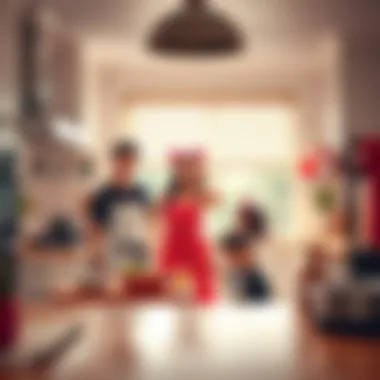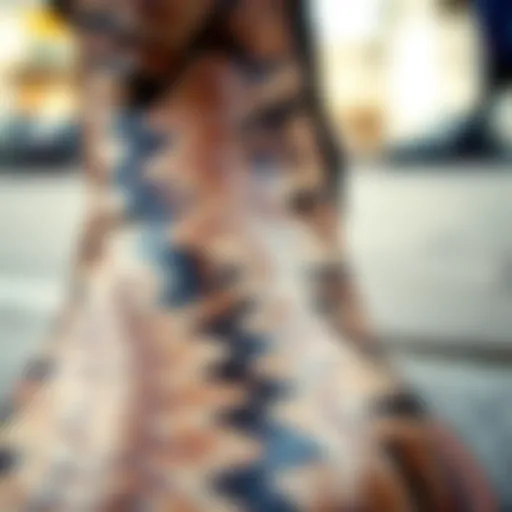Choosing the Perfect Cooking Outfit: A Comprehensive Guide


Intro
Diving into the culinary world is exciting, yet sometimes it can feel a bit overwhelming, especially when it comes to choosing what to wear. A cooking outfit needs to strike a balance between functionality, comfort, and style. Whether you're a professional chef or a home cook just looking to whip up a leisurely Sunday brunch, understanding what goes into selecting the right attire can elevate your kitchen experience. This article examines different fabric types, handy style tips, and practical maintenance advice, all designed to enhance your culinary adventure while making sure you look good doing it.
Fabric Knowledge
Choosing the right fabric for your cooking outfit is paramount. The material directly affects your comfort and how well you can perform. Here, we break down the types of fabrics commonly found in culinary clothing.
Types of Fabrics
- Cotton
A favored option for many, cotton is breathable and absorbent. Its natural fibers allow for airflow, keeping you cool while standing near the stove. However, it can wrinkle quite easily, so be prepared for some touching up. - Polyester
This synthetic marvel resists shrinkage and wrinkling. It can handle spills better than cotton due to its non-absorbent quality. Polyester blends can combine the benefits of both worlds, offering durability and ease. - Linen
Renowned for its moisture-wicking properties, linen is perfect for warm weather. While it has a lovely texture, it tends to crease more than cotton or polyester. So, if you value aesthetics and don’t mind a slight wrinkle, linen might be your go-to. - Denim
Often overlooked in the culinary world, denim provides durability and a rugged look. However, it can be heavy and may not be the best choice if you need mobility. - Spandex
Commonly used for activewear, spandex adds a dash of stretch. It offers great movability, especially essential for those bustling moments in the kitchen.
How to Care for Different Fabrics
Knowing how to care for your cooking outfit can extend its life:
- Cotton: Wash in cold water to minimize shrinkage. It can go in the dryer, but hang-drying helps avoid wrinkles.
- Polyester: Machine wash on a gentle cycle. Avoid fabric softener, as it can reduce moisture-wicking properties.
- Linen: Hand wash or use a gentle machine cycle. Hang dry to preserve its shape and texture.
- Denim: Wash less frequently to maintain color. If you do wash, inside out in cold water is best.
- Spandex: Avoid high heat when drying. Instead, let it air dry.
Maintaining your cooking attire appropriately ensures that they remain both functional and aesthetically pleasing.
Style Tips
Now, let’s get to the fun part - style! Just because you're in the kitchen doesn't mean you can't put your best foot forward. Here’s how to pair your outfits and keep up with trends.
Outfit Pairing Strategies
- Mix and Match: Don't be afraid to combine different elements. A cotton chef's jacket pairs beautifully with comfortable pants or a chic apron.
- Layering: For chilly kitchens, consider layering with a fitted long-sleeve shirt under a short-sleeve apron. It’s practical and stylish.
- Footwear Matters: Your shoes can make or break your outfit. Opt for non-slip shoes that offer plenty of support, so you’re safe on your feet.
Seasonal Fashion Trends
Fashion is ever-changing, and it's good to keep an eye on trends:
- Spring/Summer: Light fabrics such as cotton and linen in bright colors and patterns.
- Autumn/Winter: Consider layering with heavier fabrics like denim or polyester blends in darker or earth tone colors.
Understanding the Purpose of a Cooking Outfit
Selecting the right cooking outfit goes beyond just donning a set of clothes; it’s about ensuring efficiency, comfort, and the creation of an inspiring environment. The purpose of a cooking outfit hinges on three pillars: functionality, professionalism, and cultural significance. Understanding these aspects can elevate the cooking experience, whether you’re a home chef or a professional in a bustling kitchen.
Functionality in the Kitchen
When it comes to functionality, the right cooking outfit acts as a barrier between you and the kitchen’s elements. Think of boiling pots, chopping tools, and splattering sauces. The clothes need to endure spills and stains, while allowing for easy movement. Fabrics like cotton or blends offer breathability, while also being manageable to maintain. You definitely don’t want your outfit to restrict your range of motion when you reach for that top shelf, or worse, catch on a pan handle, leading to culinary calamities. An ideal cooking outfit should accommodate your tasks, whether you're sautéing, baking, or preparing fresh ingredients.
Creating a Professional Atmosphere
Adopting an appropriate cooking outfit can do wonders for your mood and discipline, especially in a professional space. Just as a well-tailored suit affects an executive’s presence in the boardroom, a properly fitted chef's coat or apron sets the stage in the kitchen. It cultivates respect—both self-respect and that from peers—when one adheres to an attire intended for culinary arts. Adding to that, a professional look can also inspire confidence in diners, making them feel that they are experiencing a meal from someone who is serious about their craft. It’s remarkable how something as simple as attire can create a distinct environment that encourages productivity and passion.
Cultural Perspectives on Cooking Attire
In different regions of the world, cooking attire carries various meanings that are intertwined with cultural identity and traditions. Some cultures may embrace bright, colorful outfits that reflect their culinary heritage, while others may opt for minimalist designs that emphasize practicality and functionality. For instance, in Japan, the traditional kimono can be adapted for the kitchen, presenting elegance alongside utility, while in France, the classic white chef's coat symbolizes a rich culinary legacy. It’s important to consider these influences as one chooses what to wear. Each outfit tells a story, making it essential to align personal values and respect for tradition with modern practicality.
"The cooking attire you choose can speak volumes about your culinary journey and respect for the arts."
In summary, understanding the purpose behind a cooking outfit is crucial as it sets the tone for both the cooking process and the culinary culture. By focusing on functionality, professionalism, and cultural relevance, one can make thoughtful choices that enhance their cooking experience, making every slice, stir, and sauté a bit more meaningful.
Key Elements of an Effective Cooking Outfit
When diving into the world of culinary wear, one must grasp the primary components that define an ideal cooking outfit. Not only does this attire need to meet functional necessities, but it also plays a vital role in comfort, style, and safety. The interaction of various elements, like materials, fit, and durability, dictates how well the outfit serves its purpose in a dynamic kitchen environment.
Material Choices
Cotton
Cotton is often hailed for its breathability and comfort. This natural fiber allows air to circulate, preventing the clammy feeling that can arise during intense cooking sessions. It's soft against the skin, which makes it an ideal choice for long hours in the kitchen.


However, while cotton is popular, it does have its drawbacks. It can absorb moisture, leading to unsightly stains if not treated quickly. One unique feature of cotton outfits is their tendency to wrinkle easily, which might not appeal to those who prefer a polished look. Nonetheless, the softness of cotton is a big draw for many cooks.
Polyester
On the other hand, polyester is celebrated for its durability and stain resistance. This synthetic fabric is less prone to wrinkling and can often be washed and dried in a snap. This robustness means that polyester garments can handle the rigorous demands of kitchen work while maintaining their form.
Yet, polyester may trap heat, making it uncomfortable during hotter days or while working near stoves. It doesn't quite match cotton in terms of comfort, especially for extended use. The lightweight nature of polyester is indeed beneficial, but one should consider how it interacts with the rigorous setting of a bustling kitchen.
Blends
Blended fabrics, usually a combination of cotton and polyester, strive to harness the best of both worlds. They typically offer a comfortable fit while being considerably more durable than their pure cotton counterparts. These blends reduce wrinkling and enhance moisture-wicking properties, which can be a solid advantage when you're racing against time during dinner service.
However, while blends can provide versatility, some may find them lacking in the breathability department, particularly when compared to pure cotton. Still, for those seeking a balance between comfort and practicality, blends represent a savvy choice.
Bamboo
Bamboo fabric is becoming increasingly popular in the culinary world due to its eco-friendliness and unique properties. It's naturally moisture-wicking, making it suitable for intense cooking environments. Bamboo is also hypoallergenic, a significant plus for those with sensitive skin.
Nevertheless, bamboo garments can sometimes be more costly and might require special care during washing. The soft texture and breathability of bamboo can offer a luxurious feel while working in the kitchen. For environmentally conscious cooks, this option resonates well beyond its practical benefits.
Fit and Mobility
Loose vs. Tight Fitting
The choice between loose and tight fitting garments can greatly influence mobility in the kitchen. Loose fitting outfits allow for freedom of movement, which is essential when performing various tasks like chopping, stirring, or reaching high shelves. This comfort can enhance performance, making cooking feel more enjoyable.
However, tight fitting attires can provide a sleek look and might even enhance performance by reducing fabric catching in kitchen tools. The main consideration is that tight clothing can sometimes restrict movement or may feel uncomfortable under long periods of usage. Thus, finding the right balance is key.
Layering Techniques
Layering in cooking attire can also impact functionality and comfort. Layering allows cooks to adapt to different kitchen climates, such as switching from a warm stovetop environment to a cooler prep area. A smart layering strategy might involve a fitted base layer topped with a more breathable outer layer.
While layering offers flexibility, it does require careful selection to ensure comfort and ease of movement. The right layers can create a versatile wardrobe that adapts seamlessly to work conditions, but one must be cautious about creating bulk, which could impair mobility during intense culinary activities.
Durability and Maintenance Requirements
An effective cooking outfit isn't just about looking good; it must withstand the rigors of the kitchen. Durability often equates to longevity, which translates to savings in the long run. When considering an outfit, check how well it holds up after several washes.
Maintenance is equally important. Whether you're washing cotton, polyester, blends, or bamboo, understanding the care instructions is crucial. Some fabrics may require delicate treatment or avoid high heat settings, impacting their lifespan significantly. A thorough understanding of these elements allows you to choose an outfit that remains functional for longer while requiring less effort to maintain.
Aesthetics in Culinary Clothing
When it comes to selecting a cooking outfit, aesthetics plays a crucial role in enhancing not just the look but also the overall experience in the kitchen. Culinary clothing is not solely a matter of functionality; it’s an opportunity to reflect personal style and create an environment that fosters creativity. A well-chosen outfit can uplift one’s mood and promote a sense of professionalism, whether in a home kitchen or a more formal culinary setting.
Colors and Patterns that Work
Selecting the right colors and patterns can influence your cooking experience significantly. Bright and bold colors can energize a space, while softer hues tend to create a calming atmosphere. For instance, a vibrant chef coat in crimson could serve to boost positivity during hectic prep times, whereas muted greens and blues might instill a sense of tranquility for more delicate cooking tasks.
Patterns also deserve attention. Stripes can create an illusion of height, which might be useful in small kitchens. Conversely, floral prints, although bold, can add a touch of freshness and vibrancy. However, it is crucial to balance style with practicality. Too complicated designs can cause distractions, whereas simple patterns often contribute to a neat, polished look.
"Your outfit speaks before you do" – in the culinary world, this couldn’t ring more true.
Personal Expression through Cooking Attire
Culinary clothing offers an excellent canvas for personal expression. Chefs and home cooks alike have the unique opportunity to communicate their personality through their attire. Adding personalized touches, like choosing a unique apron or incorporating favorite motifs into the clothing, can infuse a sense of pride and individuality into the kitchen experience.
For instance, a chef opting for clothing with avant-garde designs might reflect a more experimental cooking style, while those who wear classic and understated clothing could convey a traditional approach to cuisine. Notably, colors, patterns, and even the choice of accessories like hats and aprons can significantly impact one’s culinary narrative, inviting discussions that enhance the overall cooking atmosphere.
Trends in Chef and Home Cook Fashion
Like any other fashion domain, culinary attire trends evolve. In recent years, the lines between professional culinary uniforms and casual home cooking outfits have blurred. Many modern chefs are now embracing relaxed fits, breathable fabrics, and versatile styles. This shift signifies a broader change in the culinary world, where comfort is cherished just as much as appearance.
Popular trends include:
- Aprons: The rise of utility aprons that combine style with function, often sporting pockets and adjustable straps.
- Sustainable Materials: A growing number of cooking outfits utilize eco-friendly fabrics, responding to increasing environmental concern.
- Athleisure Influences: The comfort of athleisure wear is making its way into kitchen attire, promoting ease of movement during food preparation.


These trends not only reveal current fashion influences but also embrace a relaxed vibe in cooking settings. By blending style with comfort and practicality, culinary clothing can enhance the cooking experience substantially.
The Role of Comfort in the Kitchen
When it comes to cooking, comfort often slips through the cracks of consideration, but it is pivotal in shaping a positive culinary experience. The kitchen can be an arduous environment, with long hours spent standing, stirring pots, and chopping veggies. If the clothing doesn’t stand up to the demands of the task, not only can it hinder performance, but it may also take the joy out of cooking altogether. So, where does comfort come into play? Let’s break it down.
Importance of Breathability
Breathability in culinary attire is akin to having a cool breeze on a sweltering day. When the heat is turned up in the kitchen, the last thing a cook needs is to feel suffocated by their clothing. Materials that allow air to circulate offer significant benefits. Not only do breathable fabrics keep body temperature in check, but they also reduce perspiration buildup. Cotton and bamboo fibers are good examples of breathable materials often favored by chefs. These fibers can allow sweat to evaporate more readily, preventing discomfort from dampness.
Another point to ponder is that breathable clothing can enhance overall focus. When a chef is not distracted by the feeling of clamminess or irritation, they can concentrate better on the culinary tasks at hand. It’s tough to whip up a beautiful soufflé when you’re preoccupied with adjusting a tight waistband.
Adjustable Features for Enhanced Comfort
The significance of adjustable features in cooking outfits cannot be overstated. The kitchen is rarely a static environment, and thus, flexibility is key. Clothing with adjustable elements—like drawstrings or Velcro straps—offers tailored comfort throughout any cooking session.
For instance, a chef might begin with a fitted garment for a formal presentation but find it best to loosen it after a hot batch of spaghetti sauce has been prepared. Adjustable features provide this capability, allowing the individual to make necessary modifications without needing an entire outfit change.
Moreover, consider how much movement chefs require. It’s not just about comfort; it’s about mitigating distractions. Adjustable cuffs, for example, can prevent sleeves from dipping into sauce or snagging on kitchen tools, making them an integral component of a well-designed cooking outfit.
"The right clothing can turn a simple cooking session into a seamless experience, allowing the chef to thrive in their art."
Ultimately, comfort in the culinary realm is far from trivial. It shapes the cooking process and experience. Should wearers feel at ease, they are far more likely to engage passionately in what they create. Paying attention to both breathability and adjustable features is not merely an aesthetic choice; it’s a cornerstone of optimizing functionality in the kitchen.
Selecting the Right Footwear
In the culinary world, the feet are perhaps the most neglected part of a chef’s outfit, yet they bear the weight of long hours in the kitchen. Selecting the right footwear is not simply a matter of personal preference; it’s about safety, comfort, and overall efficiency in your kitchen endeavors. Proper footwear can seriously impact your mobility, which is crucial when you are hopping between stations, managing hot pans or dodging spills. Quickly assessing footwear choices is key to ensuring a kitchen experience that’s not only effective but also enjoyable.
Types of Shoes Ideal for Cooking
When it comes to culinary pursuits, not just any shoe will do. The right type of shoe can make a world of difference in how you function throughout the day. Here's a look at two specific types of footwear designed to rise to the occasion in the kitchen environment.
Non-slip Options
One of the most critical features to consider in cooking footwear is non-slip soles. These types of shoes significantly reduce the risk of nasty spills and unpredictability that the kitchen presents. Kitchen floors can be a minefield of slippery surfaces, thanks to oils, water, and even spillages from mismanaged ingredients. Non-slip options feature specially designed soles that grip the floor, providing stability and traction.
This attribute is essential, especially in bustling commercial kitchens where the pace is swift and demands are high. Investing in shoes with high-quality non-slip soles isn't merely a fashion choice; it's a safety necessity. However, while they offer safety, it's worth noting that some non-slip shoes can be a bit bulkier than traditional footwear. So, striking a balance between functionality and style becomes crucial.
Comfort vs. Style
Comfort and style often find themselves at odds in various footwear discussions, and the kitchen is no different. The demands of standing for hours on end call for shoes that provide exceptional comfort. Overly stylish shoes may lack the necessary support for your arches, leading to fatigue in only a few hours. On the flip side, wearing comfortable shoes that are less fashionable can leave some feeling self-conscious in a professional culinary setting. Brands have started to take note of this dilemma, producing options that blend both aspects. For instance, you might find sleek designs that don’t compromise on cushioning and support. Ultimately, the key lies in prioritizing comfort while still opting for a style that aligns with your image in the kitchen. Each chef’s environment is different; what feels stylish to one might feel like old slippers to another. It’s a personal equation worth solving.
Considerations for Foot Health
It’s easy to overlook the importance of healthy footwear, especially when caught up in the hustle of cooking. Long hours in the kitchen can lead to various foot-related issues if the proper attention isn't paid to foot health. Look for shoes that provide adequate arch support to prevent discomfit, which can rapidly derail a busy cooking session.
Additionally, consider ventilation and moisture-wicking materials to keep feet dry and prevent the buildup of odor. Don't forget to think about the fit! Shoes that are too tight can pinch and provoke blisters, whereas overly loose shoes can lead to tripping and poor posture.
When you're choosing your cooking shoes, remember, they are integral to your culinary performance. Prioritizing safety, comfort, and health will create a happier cooking experience.
Maintaining Your Cooking Outfit
Keeping a cooking outfit looking sharp and in good condition is as crucial as selecting the right attire in the first place. Similar to how we maintain a kitchen's cleanliness for safety and efficiency, taking care of culinary clothing ensures they not only last longer but also maintain their professional appearance. A well-maintained cooking outfit reflects a cook’s attention to detail, which is integral to their overall kitchen presence, whether they’re a professional chef or a home cook entertaining friends on a weekend.
Washing and Care Instructions
Following proper washing and care instructions can make a world of difference for your cooking outfit. Here are some tips to keep your outfit crisp and clean:
- Read the labels: Fabric care labels provide essential guidelines for washing and drying. Ignoring them can lead to mishaps, like shrunken clothing or colors bleeding.
- Use cold water: Washing in cold water helps maintain colors and shapes. It’s a gentle approach, keeping fabrics from fraying or fading quickly.
- Air dry whenever possible: If you can, hang your outfits to dry instead of tossing them into the dryer. Heat can weaken fibers over time.
- Spot clean stains: When time is of the essence, a quick spot clean can save your outfit from needing a full wash. Use a soft cloth and mild soap for a gentle cleanse.
In addition to these practical steps, regular inspections of your cooking garments can prevent minor issues from becoming significant problems. Look out for fraying seams, loose buttons, or any signs of wear and tear. Address them promptly to avoid wearing out your favorite outfit unexpectedly.
Stain Removal Techniques
Stains are an inevitable part of cooking, but knowing how to tackle them means you can maintain the integrity of your outfit. Here are effective techniques for removing common stains:
- Food Stains: For oil or tomato sauce stains, gently blot the area with a paper towel before applying a mixture of dish soap and water. Let it sit for about 10 minutes before rinsing.
- Wine Stains: If you spill wine on your outfit, sprinkle salt on it as it helps absorb the liquid. After a few minutes, brush it off and wash as per the care instructions.
- Grease Stains: Baking soda can be your best friend when attacking grease. Sprinkle it on the stain, let it absorb the grease, then brush it off and treat it with soapy water.


"A well-maintained cooking outfit speaks volumes, projecting an image of competence and style in the kitchen."
Staying ahead in maintaining your cooking outfit not only extends its life but also saves money long-term. Plus, let's face it, nobody enjoys the added task of replacing damaged attire just because the care was neglected. By keeping your cooking outfit clean and in shape, you ensure comfort, practicality, and that touch of flair that’s essential for any culinary experience.
Shopping for Cooking Outfits
Embarking on the quest for the ideal cooking outfit is akin to donning armor before a battle. What you choose to wear in the kitchen must not only resonate with your style but also stand up to the rigors of culinary activity. The process of shopping for cooking outfits is essential as it affects both your efficiency and your emotional connection to the craft.
When searching for the right attire, consider it an investment in your comfort and the overall atmosphere of your cooking space. A good outfit can elevate your culinary experience, making it enjoyable and productive. Missing out on proper attire can lead to discomfort, distractions, or even a lackluster performance. In short, taking the time to select a quality cooking outfit can yield dividends in your kitchen endeavors.
Identifying Reliable Brands
In the realm of cooking outfits, the importance of aligning with trustworthy brands cannot be understated. When you find a brand that meets high standards for both quality and style, it simplifies your search possibilities significantly. Reliable brands typically invest in high-grade materials and focus on functional designs.
Here are a few factors to consider when evaluating brands:
- Reputation: Do some homework. Look up customer reviews on platforms such as Reddit and check ratings to get a feel for the brand's standing.
- Material Certifications: Brands showcasing sustainable practices often indicate a commitment to quality materials, like organic cotton or hypoallergenic fabrics.
- Industry Endorsements: If professional chefs or culinary schools endorse a brand, that can speak volumes about the quality and practicality of its products.
"Your choice of cooking outfit is more than just a wardrobe decision; it’s an embodiment of your culinary commitment and personal flair."
Understanding Price vs. Quality Dynamics
Navigating the price-to-quality relationship can feel like walking a tightrope; too little investment might leave you with garments that fray at the seams, while overspending doesn’t always guarantee satisfaction. Instead, aim for balance. Here are few pointers that can help you grasp this dynamic:
- Evaluate Cost-Effectiveness: Sometimes, spending a little more on a well-made outfit pays off in durability. It’s crucial to analyze the lifespans of garments relative to their price.
- Sales and Discounts: Keep an eye out for seasonal sales which can afford you quality items at a fraction of the cost. Just ensure that the slashed prices don’t come at the expense of quality.
- Long-Term Use: Consider how often you will wear the outfit. A daily-use chef coat should be robust, making it worthwhile to extend that budget.
Personalizing Your Cooking Outfit
Personalizing your cooking outfit is not just a matter of aesthetics; it necessitates an understanding of one's culinary environment, individual style, and practical requirements. A personalized cooking outfit reflects your unique personality while also promoting efficiency and comfort. An outfit tailored to your personality can transform cooking from a mundane task into a delightful experience, ultimately inspiring creativity in the kitchen.
Accessorizing for Added Flair
When you delve into accessorizing your cooking outfit, consider how small touches can differentiate you from the crowd. Accessories serve not only to enhance your look but also to improve functionality. For instance, a stylish apron with pockets made from durable cotton can hold essential tools while allowing you to express your flair.
- Utility-focused items: Think chef hats, aprons or even kitchen towels in chic patterns or colors.
- Functional jewelry: Some might opt for minimalist bracelets that remain out of the way but add a dash of elegance.
- Footwear: Non-slip shoes can come in vibrant colors or unique designs, marrying safety with style.
Accessorizing can also provide layers of protection, from shielding your clothing from stains to serving as a conversation starter. If you cook often, swapping out your accessories can keep your look fresh and engaging.
Monogramming and Custom Options
Monogramming and custom options bring an extra layer of intimacy to your cooking attire. A monogrammed chef coat or apron, for instance, offers a unique signature that personalizes your cooking experience.
- Custom Design: You can collaborate with designers to create outfits that represent not just your culinary role but also your interests.
- Monogram Variations: Choose different fonts or colors for your initials, allowing a blend of professionalism with your personality.
- Individualized Patterns: Some companies offer custom fabric patterns; this could be a fun abstract print that reflects your spirit.
Choosing customizable elements conveys thoughtfulness and dedication to the craft.
Personalizing your cooking attire can elevate not only your style but also the overall cooking experience, as you’ll feel more connected to your environment.
In summary, the intricacies of personalization can foster a more inviting atmosphere in the kitchen while reflecting the essence of who you are. From accessorization to custom designs, embracing these choices allows you to curate an outfit that is not just about cooking, but also about expressing individuality amidst the everyday bustle.
Ending: The Essence of a Thoughtful Cooking Outfit
Selecting the ideal cooking outfit is not just about looking good while whipping up culinary masterpieces. It’s about creating a harmonious blend between functionality, comfort, and personal style. As we’ve explored, each piece of clothing serves a purpose - from protecting against splatters to promoting ease of movement.
A well-considered cooking outfit can be the difference between a stress-free experience and a regrettable escapade in the kitchen. For instance, when cooking for a lengthy period, breathable fabrics can make all the difference in comfort. One can feel weighed down and irritated in heavy attire, while the right choice can make you feel like a culinary artist painted by inspiration.
"A chef’s uniform is like a soldier’s armor; it prepares you for the tasks ahead."
Balancing Practicality and Aesthetics
In our daily lives, practicality is often prioritized, but let’s not neglect aesthetics. A practical cooking outfit can come in a variety of styles, colors, and designs. For example, choosing a vibrant apron made from durable cotton not only serves the purpose of protection but adds life to a usually plain kitchen setting. The visual appeal of clothing can even impact one's cooking experience — a pop of color here and there can lift your spirits and make culinary endeavors more enjoyable.
- Consider the environment: If you often find yourself cooking in a bustling restaurant or hosting intimate dinners, your attire should reflect the occasion.
- Layer wisely: Different occasions may require different layers. A lightweight chef jacket can be thrown on or off depending on the heat of the kitchen.
Ultimately, blending these two elements doesn't have to be a chore. There are numerous brands that are reinterpreting culinary uniforms with style, integrating trendy elements into traditional designs. For instance, consider a tailored chef coat paired with tapered trousers, delivering a modern yet functional look.
Final Thoughts on Culinary Style
In the realm of culinary arts, personal expression is significant. The clothes you wear while cooking can represent a reflection of who you are. Whether it’s through custom embroidery, mismatched colors, or vintage pieces, your cooking outfit tells your story. Thus, it’s crucial to think about what message your attire sends.
Fashion enthusiasts will find joy in experimenting with styles — mixing and matching textures, colors, and accessories to elevate their culinary experience. The goal should always be to cultivate an ensemble that feels authentic and comfortable.















